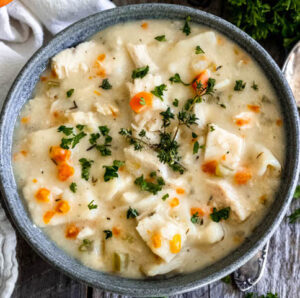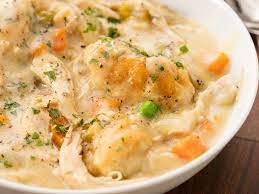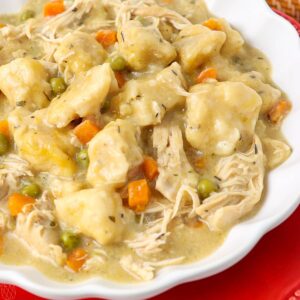Chicken and Dumplings: Comfort Food with Deep Roots

Of the many fond memories I have of visiting my grandmother on her farm in southeastern Oklahoma, my favorites revolve around mealtimes. Even in her old age, Grandmother was always up at the crack of dawn tending to the daily chores—milking the two cows, feeding the chickens, and drawing water from the well.
My parents, aunts, uncles, and I were usually awakened by the smell of coffee brewing and the sound of Grandmother preparing breakfast—always bacon, ham, or sausage, with fresh eggs and her homemade biscuits. As soon as breakfast was over and the dishes were cleaned, it was time to start dinner (or what some of you might call lunch). One of my absolute favorites was her chicken and dumplings.
 It all started with Grandmother going out to the chicken yard, selecting an old hen or two—it seemed like she never ran out of chickens—wringing their necks, plucking the feathers, then dipping them in the old black cauldron of scalding water to remove any pin feathers. After that, she’d put those yardbirds on the stove to boil in a pot of water with onion, celery, and carrots until they were fall-off-the-bone tender. While that was taking place, she would start making her dumplings.
It all started with Grandmother going out to the chicken yard, selecting an old hen or two—it seemed like she never ran out of chickens—wringing their necks, plucking the feathers, then dipping them in the old black cauldron of scalding water to remove any pin feathers. After that, she’d put those yardbirds on the stove to boil in a pot of water with onion, celery, and carrots until they were fall-off-the-bone tender. While that was taking place, she would start making her dumplings.
Served with a side of green beans, squash, or collard greens from her garden, and crunchy cornbread—brother, I was in heaven.
While chicken and dumplings feels like pure Southern comfort food—the kind of thing you’d expect to find on a farmhouse table—its story stretches far beyond the South. Like so many dishes we claim as our own, it began as a traveler, crossing oceans and centuries before settling into American kitchens. Dumplings themselves are an ancient idea, appearing in European cooking as far back as the 1600s. Germans made knödel, English cooks used suet dumplings, and across Europe, the same truth held: a pot of meat and vegetables could be stretched and enriched with a few bits of dough.
 When these traditions came to North America, they adapted to local tastes and ingredients. Early American cookbooks reflect this shift. Mary Randolph’s The Virginia House-wife (1836) included suet dumplings served with stewed meat. Lettice Bryan’s The Kentucky Housewife (1838) did the same, this time with mutton. At this point, chicken wasn’t the star—beef, pork, and mutton were more common in stews.
When these traditions came to North America, they adapted to local tastes and ingredients. Early American cookbooks reflect this shift. Mary Randolph’s The Virginia House-wife (1836) included suet dumplings served with stewed meat. Lettice Bryan’s The Kentucky Housewife (1838) did the same, this time with mutton. At this point, chicken wasn’t the star—beef, pork, and mutton were more common in stews.
That changed in 1879 when Marion Cabell Tyree’s Housekeeping in Old Virginia offered the first known printed recipe for chicken and dumplings as we know it: stew the chicken, roll biscuit-like dough thin, cut it into strips, and drop it into the simmering broth. Her method is still recognizable today.
Some claim the dish was born in the Great Depression as a frugal staple, but in truth, 19th-century chicken was a luxury. Most hens were kept for eggs, not meat, so slaughtering one meant you were serving something special. Paired with dumplings, it became a celebratory meal.
Over time, regional styles emerged. In the South, dumplings were rolled thin into pastry-like strips, sometimes called “slicks” or “slickers.” In eastern North Carolina, the dish became “chicken and pastry.” In the North, dumplings were often dropped by spoonfuls into the broth, puffing into tender clouds.  The Pennsylvania Dutch had bott boi—square noodles in broth with chicken, ham, or beef—and French Canadian cooks made similar pots of meat and dumplings.
The Pennsylvania Dutch had bott boi—square noodles in broth with chicken, ham, or beef—and French Canadian cooks made similar pots of meat and dumplings.
Whatever the form, the appeal was the same: savory, satisfying, and meant for sharing. Even popular culture embraced it—She’ll Be Coming ’Round the Mountain promises, “We’ll all have chicken and dumplings when she comes.”
By the mid-20th century, chicken and dumplings had become an American comfort-food classic. Magazine editors, community cookbooks, and even commercial brands helped spread it far beyond its regional roots. Whether ladled out in a church basement, served at a small-town diner, or simmered in a home kitchen, the essentials never changed: good broth, tender chicken, and dumplings that turn a pot into something greater than the sum of its parts.
Looking back, it’s clear chicken and dumplings isn’t the product of any single place or moment. It grew out of a long tradition of pairing meat and dumplings, shaped by European heritage, adapted to American kitchens, and refined over generations. The first American recipe may have appeared in 1879, but the dish had been simmering in the culture long before that—proof that sometimes the simplest meals are the ones with the richest histories.


